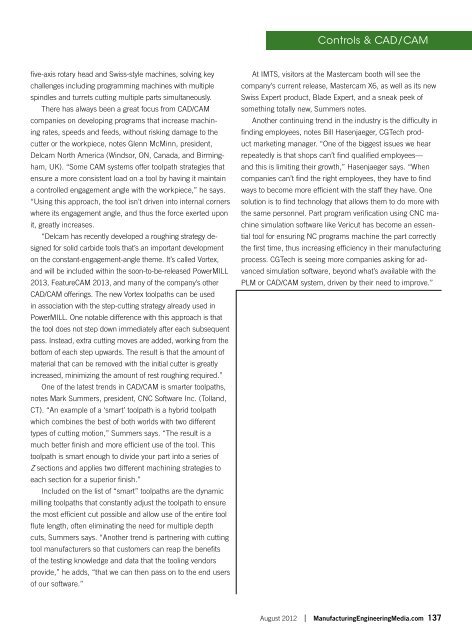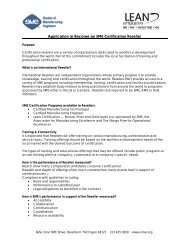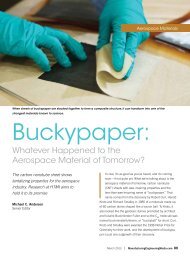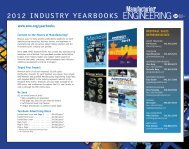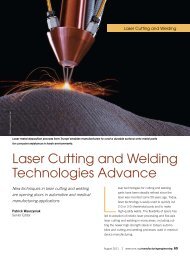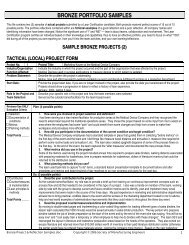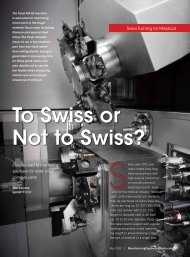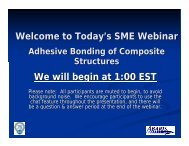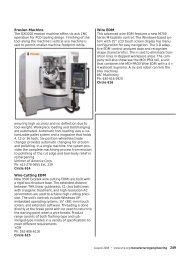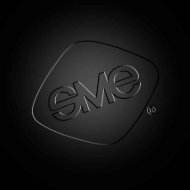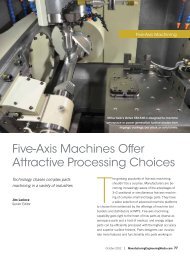Click here for PDF - Society of Manufacturing Engineers
Click here for PDF - Society of Manufacturing Engineers
Click here for PDF - Society of Manufacturing Engineers
You also want an ePaper? Increase the reach of your titles
YUMPU automatically turns print PDFs into web optimized ePapers that Google loves.
Controls & CAD/CAM<br />
five-axis rotary head and Swiss-style machines, solving key<br />
challenges including programming machines with multiple<br />
spindles and turrets cutting multiple parts simultaneously.<br />
T<strong>here</strong> has always been a great focus from CAD/CAM<br />
companies on developing programs that increase machining<br />
rates, speeds and feeds, without risking damage to the<br />
cutter or the workpiece, notes Glenn McMinn, president,<br />
Delcam North America (Windsor, ON, Canada, and Birmingham,<br />
UK). “Some CAM systems <strong>of</strong>fer toolpath strategies that<br />
ensure a more consistent load on a tool by having it maintain<br />
a controlled engagement angle with the workpiece,” he says.<br />
“Using this approach, the tool isn’t driven into internal corners<br />
w<strong>here</strong> its engagement angle, and thus the <strong>for</strong>ce exerted upon<br />
it, greatly increases.<br />
“Delcam has recently developed a roughing strategy designed<br />
<strong>for</strong> solid carbide tools that’s an important development<br />
on the constant-engagement-angle theme. It’s called Vortex,<br />
and will be included within the soon-to-be-released PowerMILL<br />
2013, FeatureCAM 2013, and many <strong>of</strong> the company’s other<br />
CAD/CAM <strong>of</strong>ferings. The new Vortex toolpaths can be used<br />
in association with the step-cutting strategy already used in<br />
PowerMILL. One notable difference with this approach is that<br />
the tool does not step down immediately after each subsequent<br />
pass. Instead, extra cutting moves are added, working from the<br />
bottom <strong>of</strong> each step upwards. The result is that the amount <strong>of</strong><br />
material that can be removed with the initial cutter is greatly<br />
increased, minimizing the amount <strong>of</strong> rest roughing required.”<br />
One <strong>of</strong> the latest trends in CAD/CAM is smarter toolpaths,<br />
notes Mark Summers, president, CNC S<strong>of</strong>tware Inc. (Tolland,<br />
CT). “An example <strong>of</strong> a ‘smart’ toolpath is a hybrid toolpath<br />
which combines the best <strong>of</strong> both worlds with two different<br />
types <strong>of</strong> cutting motion,” Summers says. “The result is a<br />
much better finish and more efficient use <strong>of</strong> the tool. This<br />
toolpath is smart enough to divide your part into a series <strong>of</strong><br />
Z sections and applies two different machining strategies to<br />
each section <strong>for</strong> a superior finish.”<br />
Included on the list <strong>of</strong> “smart” toolpaths are the dynamic<br />
milling toolpaths that constantly adjust the toolpath to ensure<br />
the most efficient cut possible and allow use <strong>of</strong> the entire tool<br />
flute length, <strong>of</strong>ten eliminating the need <strong>for</strong> multiple depth<br />
cuts, Summers says. “Another trend is partnering with cutting<br />
tool manufacturers so that customers can reap the benefits<br />
<strong>of</strong> the testing knowledge and data that the tooling vendors<br />
provide,” he adds, “that we can then pass on to the end users<br />
<strong>of</strong> our s<strong>of</strong>tware.”<br />
At IMTS, visitors at the Mastercam booth will see the<br />
company’s current release, Mastercam X6, as well as its new<br />
Swiss Expert product, Blade Expert, and a sneak peek <strong>of</strong><br />
something totally new, Summers notes.<br />
Another continuing trend in the industry is the difficulty in<br />
finding employees, notes Bill Hasenjaeger, CGTech product<br />
marketing manager. “One <strong>of</strong> the biggest issues we hear<br />
repeatedly is that shops can’t find qualified employees—<br />
and this is limiting their growth,” Hasenjaeger says. “When<br />
companies can’t find the right employees, they have to find<br />
ways to become more efficient with the staff they have. One<br />
solution is to find technology that allows them to do more with<br />
the same personnel. Part program verification using CNC machine<br />
simulation s<strong>of</strong>tware like Vericut has become an essential<br />
tool <strong>for</strong> ensuring NC programs machine the part correctly<br />
the first time, thus increasing efficiency in their manufacturing<br />
process. CGTech is seeing more companies asking <strong>for</strong> advanced<br />
simulation s<strong>of</strong>tware, beyond what’s available with the<br />
PLM or CAD/CAM system, driven by their need to improve.”<br />
August 2012 | <strong>Manufacturing</strong>EngineeringMedia.com 137


